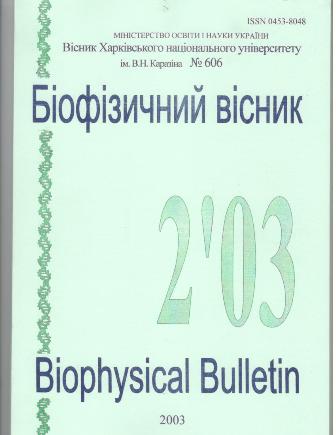Indicator dye behavior in the system glucose oxidase + glucose
Abstract
Using the absorption spectroscopy technique the group of indicator dyes including bromocresol purple, phenol red, neutral red, auramine O and acridine orange has been examined from the viewpoint of the dye applicability to the design of optical glucose biosensors. The absorbance changes of bromocresol purple, phenol red and neutral red observed in the glucose oxidase + glucose system were interpreted ui terms of the dye sensitivity to the pH reduction occurring while glucose is catalytically oxidized. The arguments in favor of neutral red interaction with glucose oxidase are obtained.
Downloads
References
Vo-Dinh T, Cullum B. Fresenius J. Anal. Chem. 2000;366:540-51.
Fraser DM. Medical Device Technology. 1994;5:44-7.
Ravi Shankaran D, Uehara N, Kato K. Biosensors and Bioelectronics. 2003;18:721-8.
Bianco P. Reviews in Molecular Biochnology. 2002;82:393-409.
Rosenzweig Z, Kopelman R. Anal. Chem. 1996;68:1408-13.
Mehrvar M, Bis C, Scharer JM, Moo-Young M, Luong JH. Analytical Sciences. 2000;16:677-92.
Potyrailo RA, Hobbs SE, Hieftje GM. Fresenius J. Anal. Chem. 1998;362:349-73.
Mchedlov-Petrossyan NO, Isaenko YuV, Salamanova NV, Alekseeva VL, Savvina LP. Journal of Analytical Chemistry. 2003;58:1018-30.
Gorbenko GP, Mchedlov-Petrossyan NO, Chernaya TA. J. Chem. Soc., Faraday Trans. 1998;94:2117-25.
Authors who publish with this journal agree to the following terms:
- Authors retain copyright and grant the journal right of first publication with the work simultaneously licensed under a Creative Commons Attribution License that allows others to share the work with an acknowledgement of the work's authorship and initial publication in this journal.
- Authors are able to enter into separate, additional contractual arrangements for the non-exclusive distribution of the journal's published version of the work (e.g., post it to an institutional repository or publish it in a book), with an acknowledgement of its initial publication in this journal.
- Authors are permitted and encouraged to post their work online (e.g., in institutional repositories or on their website) prior to and during the submission process, as it can lead to productive exchanges, as well as earlier and greater citation of published work (See The Effect of Open Access).





